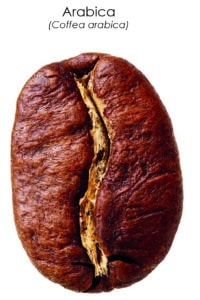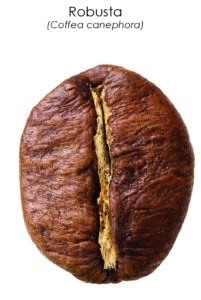Coffea arabica, also just called “Arabica”
The Arabica beans originally come from Ethiopia, and are widely regarded as a high-quality coffee, with good taste and flavor. The Arabica bean is grown at high altitudes and has a delicate, complex flavor profile with notes of fruit and acidity. Arabica come in many different varieties, each with unique characteristics. In the coffee world Bourbon and Typica are considered the “original” Arabica, and forms the basis of modern arabica coffee cultivation. Bourbon has a sweet and fruity flavor profile with hints of caramel and chocolate. Typica is known for its balanced flavor profile and low acidity. Today, Arabica is grown in many countries such as Brazil, Colombia, Costa Rica, Ethiopia, Kenya, and Tanzania. Arabica coffee accounts for around 60% of global coffee production (2023).
The Arabica plant is a large bush with dark-green oval leaves and grows best in mountain climates in the altitude between 800-2,200 meters above sea level (MASL). In countries far from the equator, the coffee is grown in low altitudes from 800 MASL and for countries closer to the equator, is the coffee grown in altitudes like 1200 MASL. The altitude contributes to the desired temperature and amount of rain, and the arabica coffee plants require a temperature of 15-25°C. In colder areas the growth and development of the coffee is slower, which gives the coffee a better flavour and aroma. The fruits, or cherries, are rounded and mature in 9 to 11 months. It’s important to note that the ripening time for coffee berries can vary depending on a variety of factors, such as the climate, altitude, soil conditions, and other environmental factors. Arabica beans usually contain two flat seeds which are oval in shape and have a distinct “S” curve. Arabica is more vulnerable than Robusta and requires soil with a low pH value and light shade. Due to the vulnerability of the plant, the production of Arabica coffee is known to give less coffee compared to Robusta.

Coffea canephora, also just called “Robusta”
Robusta is a hardy and disease-resistant coffee, which means it can grow in cool lowland areas, which makes it easier to grow than Arabica. Robusta is more susceptible against diseases, insect attacks and temperature fluctuations. Robusta is a small tree that grows up to 10 metres high and they yield more crop per tree than arabicas . The plants can grow between 0-900 MASL and they require a temperature of 18-30°C and a lot more rain than the Arabica does. The fruits are rounded and take 9-10 months to mature; the seeds are oval in shape and smaller than Arabica seeds. Like the arabica it’s important to note that the ripening time for coffee berries can vary depending on a variety of factors, such as the climate, altitude, soil conditions, and other environmental factors.
obusta beans tend to have a stronger bitter flavor profile with a grain-like overtone and peanutty aftertaste and has a low acid content. Robusta beans can contain twice as much or more caffeine compared to arabica beans, and they are generally considered to be of lower quality compared to arabica. Some robustas, however, are of high quality and valued especially in espressos for their deep flavor and good crema and are a wide range of varieties and qualities. Robusta accounts for around 40% of global coffee production (2023).
